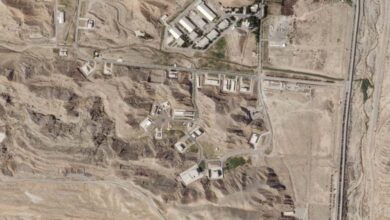Details of Israel’s first airborne landing of its kind in Syria

Four Israeli helicopters flew at low altitude over the Kesswa area, south of Damascus, dropping parachutes to begin a ground inspection operation, just two days after Syrian troops had discovered surveillance and espionage devices.
According to Syrian state media, the Israeli army carried out an airborne landing at a military site near Damascus overnight Wednesday to Thursday, after striking the same target twice earlier in the week, on Tuesday and Wednesday.
-
Israeli army approves guidelines for Gaza offensive
-
Israeli Army Preparing to Occupy Gaza City with a Quarter Million Soldiers
On Tuesday, an Israeli strike hit the site near the city of Kesswa in rural Damascus, killing six Syrian soldiers, according to the Syrian Ministry of Foreign Affairs. Israel renewed its attack on the area Wednesday evening, Syrian state television reported.
SANA news agency, quoting a government source, stated that on Tuesday, Syrian troops had found surveillance and espionage equipment near Mount al-Mani. While attempting to deal with it, the site was struck by an Israeli air raid that caused casualties, injuries, and vehicle destruction.
A Syrian Defense Ministry official, speaking anonymously to AFP, said that the targeted location at Tall al-Mani was once a military base.
-
The Rafah Brigade Remains a Military Challenge for the Israeli Army in Gaza
-
Hamas Remaining in Power and Ceasefire Demand: Israeli Army’s Requests Anger Netanyahu
SANA further reported that on Wednesday evening, Israeli aircraft carried out multiple raids on the site, followed by an airborne landing whose full details remain unknown, while Israeli reconnaissance drones continued to circle overhead.
The UK-based Syrian Observatory for Human Rights noted that the targeted location was a large missile storage facility formerly used by Hezbollah, Iran’s ally in Lebanon. It added that four Israeli helicopters flew at low altitude over Kesswa, deploying paratroopers to conduct a search operation.
According to the Observatory, this was the first Israeli airborne landing of its kind in Syria since the fall of President Bashar al-Assad’s regime on December 8, 2024.
-
The Israeli army is preparing for surprise Hamas weapons in the event of a ground invasion
-
Lebanese Army Uncovers Israeli Spy Devices Hidden with Precision
The Syrian news outlet “Enab Baladi” quoted a Syrian army officer saying the operation occurred without direct clashes with Defense Ministry personnel nearby. It reportedly lasted more than two hours, though its purpose and objectives remain unclear.
This operation is part of Israel’s long-standing campaign of airstrikes on Syrian military positions, which it justifies as efforts to prevent advanced weapons from reaching Hezbollah or other regional actors.
The raids also coincide with ongoing security talks between Israel and Syria aimed at de-escalation.
-
Latest News from Gaza: Intensified Israeli Bombardment and Tanks Advancing to the City’s Entrance
-
From the Battlefield to the Therapist’s Office: Gaza Haunts Israeli Soldiers Without Firing a Bullet
The al-Mani hill area, home to a military installation, has repeatedly been targeted before and after the Syrian regime’s collapse. It was formerly the headquarters of the 1st Division of the Syrian army and served as a base for bombarding opposition-held territories in western Damascus.
Israel has struck the region before, including on February 8, 2024, when it targeted a Hamas weapons depot in Deir Ali, south of Damascus. At the time, Israeli army spokesperson Avichay Adraee confirmed that the stored weapons were meant for attacks against Israeli forces.
-
A Break in Khan Younis Gets Elite Israeli Unit Pulled from Gaza
-
Stalled Gaza Truce Talks… The Israeli Withdrawal Map Sparks Fresh Tensions
This was not the first time Israel carried out such operations. In September 2024, Israeli airstrikes targeted the city of Masyaf in western Hama, destroying a scientific research facility and killing 18 people. Israeli and international reports indicated that the facility hosted Iranian military infrastructure and was being used to develop weapons and missiles for Tehran and its allies.
The Israeli press also revealed that the strike was accompanied by a commando raid, during which Israeli forces seized intelligence documents and destroyed strategic installations.
These developments highlight a significant escalation in Israel’s strategy, which now combines traditional airstrikes with direct airborne landings, reflecting the growing intensity of the regional security confrontation.
-
Latest from Gaza: Ongoing Israeli Airstrikes and Ceasefire Negotiation Details
-
Arming and Funding… Is Israel Repeating the Lahad Army Experience in Gaza?











